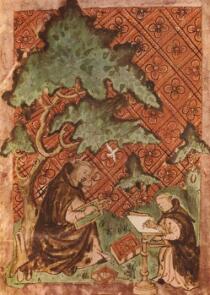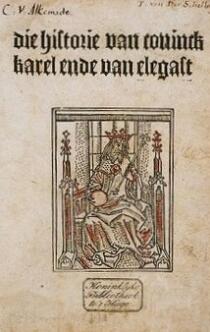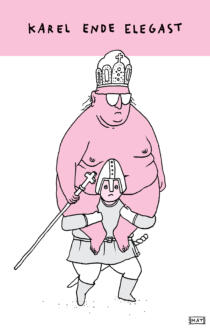The Espousals describes this love affair from the preparation stage to the highest plane. All the steps of this development and the risks specific to them are explained. Furthermore, the essence of mysticism is separated from all the ecstatic phenomena, such as visions. Nor can Christian mysticism be pantheistic, according to Ruusbroec: in the highest unity with God, humanity does not dissolve into the divine but retains its created nature.
The structure interweaves two other structures: on the one hand, the division (into four parts) of a verse from the Gospel of Matthew, and on the other, the development of the mystic life (in three steps). The four-part verse from Matthew reads: See, / the Bridegroom cometh; / go out / to meet him. It describes the key elements of an encounter: (1) your eyes must be clear; (2) then you can see that Christ the Bridegroom is approaching; (3) you will be invited to go to him when it is your turn; (4) this mutual coming together culminates in the meeting.
Each of the elements is given its own interpretation according to the three steps of the mystic life: the active, the inner and the contemplative life. These three lives are actually three ways of continually deepening love. In the active life, one experiences this love actively, with the internal and external practice of virtue and with the intention of only aspiring to honour God and to do good for one’s neighbour in everything one does.
The same love is experienced in the inner life by letting all faculties become one in the core of the soul (the being, the ground), where God touches people lovingly, where He draws them round and invites them in. In the contemplative life, the person is elevated above his or her own being into the Divine Beloved. He/she has given up his or her own self as the centre of the universe and from henceforward will live from the perspective of the Other. Each higher step does not eliminate the step before but in fact brings it to completion. The inner life does not, therefore, lead to the abandonment of all activity but refines it instead: rather than erase the intimate relationship of the inner life, the contemplative life makes it even more fervent.
Ruusbroec is very harsh towards those who renounce all active and emotional experience in the name of a purely passive, spiritual mysticism. For him, the mature mystic is a “common man”: by being fully immersed in God, he gives himself completely to the people.
The combination of a three-part and a four-part division means that The Espousals is composed of twelve parts, which in turn are neatly subdivided. For example, for the inner life, the phrase “the Bridegroom cometh” is further divided in accordance with Ruusbroec’s psychological insights, into: (1) the arrival in the heart (the centre of affection), (2) the arrival in the three higher faculties (memory, mind and will), and (3) the arrival in the depths of the soul, where the three faculties are one.
The Espousals has thus a clear main structure, but within these powerful walls are ever-smaller details that evoke comparisons with a Gothic cathedral. One could also relate it to a spiral: the four elements from Matthew’s verse return three times but each time on a higher level.






